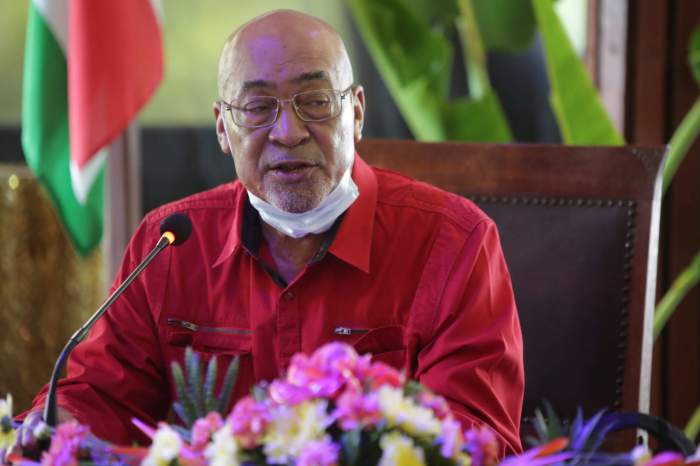By Lucia Mutikani
WASHINGTON (Reuters) – The U.S. trade deficit fell for the first time in six years in 2019 as the White House’s trade war with China curbed the import bill, keeping the economy on a moderate growth path despite a slowdown in consumer spending and weak business investment.
The report from the Commerce Department on Wednesday also showed the Trump administration’s “America First” agenda decreased the flow of goods last year, with exports posting their first decline since 2016. President Donald Trump, who has dubbed himself “the tariff man,” has pledged to shrink the deficit by shutting out more unfairly traded imports and renegotiating free trade agreements.
Trump has argued that substantially cutting the trade deficit would boost annual economic growth to 3% on a sustainable basis. The economy has, however, failed to hit that mark, growing 2.3% in 2019, which was the slowest in three years, after expanding 2.9% in 2018.
With tensions in the 19-month U.S.-China trade war easing, last year’s narrowing in the deficit is unlikely to be repeated.
“Since that entire drop came from the huge change in the China deficit, don’t expect further declines in the years to come,” said Joel Naroff, chief economist at Naroff Economic Advisors in Holland, Pennsylvania.
The trade deficit dropped 1.7% to $616.8 billion last year, declining for the first time since 2013. That represented 2.9% of GDP, down from 3.0% in 2018.
Goods imports plunged 1.7% last year, also the first decrease in three years. The United States imported 2.4 billion barrels of crude oil, the fewest since 1992, as the country significantly reduced its dependence of foreign oil amid a surge in production and exploration.
It also imported fewer capital and other goods. The 1.3% tumble in exports was led by decreases in shipments of capital goods, industrial supplies and materials, and other goods.
At the height of the U.S.-China trade war last year, Washington slapped tariffs on billions worth of Chinese goods, including consumer products, thumping imports.
The politically sensitive goods trade deficit with China plunged 17.6% to $345.6 billion in 2019.
The White House has also sparred with other trading partners, including the European Union, Brazil and Argentina, accusing them of devaluing their currencies at the expense of U.S. manufacturers. But those efforts did little to rein in the goods trade deficit with the EU, which reached an all-time high of $177.9 billion. The deficit with Mexico jumped to a record high of $101.8 billion.
Washington and Beijing signed a Phase 1 trade deal last month. The deal, however, left in place U.S. tariffs on $360 billion of Chinese imports, about two-thirds of the total.
Goods imports rebounded sharply in December, boosting the trade deficit 11.9% to $48.9 billion that month. Economists polled by Reuters had forecast the trade gap would widen to $48.2 billion in December.
TEMPORARY BOOST
When adjusted for inflation, the goods trade deficit increased $4.3 billion to $80.5 billion in December.
Trade added almost 1.5 percentage points to GDP growth in the fourth quarter, exceeding the 1.20 percentage points contribution from consumer spending, which accounts for more than two-thirds of U.S. economic activity. The economy grew at a 2.1% annualized rate in the fourth quarter, matching the pace notched in the July-September period.
Though the trade deficit is expected to swell, the economy is likely to continue growing moderately, with other reports on Wednesday showing a pickup in activity in the services sector and private employers boosting hiring in January.
The Institute for Supply Management (ISM) said its non-manufacturing activity index increased to a reading of 55.5 last month from 54.9 in December. A reading above 50 indicates expansion in the services sector, which accounts for more than two-thirds of U.S. economic activity.
The report came on the heels of a survey from the ISM on Monday showing manufacturing rebounded in January after contracting for five straight months.
Separately, the ADP National Employment Report showed private payrolls jumped by 291,000 jobs in January, the most since May 2015, after increasing by 199,000 in December. Private payrolls were likely flattered by unusually mild weather and a seasonal quirk, amid signs that overall job growth has slowed.
The ADP report has a poor record predicting the private payrolls component of the government’s more comprehensive employment because of methodology differences. January’s employment report is scheduled for release on Friday.
“We are always skeptical of the ADP’s accuracy and that scepticism is doubled every January because firms tend to purge names from the payroll at the start of the year, even though those people may not have done and paid work for that firm for several months,” said Paul Ashworth, chief U.S. economist at Capital Economics in Toronto.
“That distortion occasionally used to generate very weak readings at the start of the year but, in this case, it looks like the ADP could have over-compensated with an adjustment.”
The dollar rose against a basket of currencies, while prices of U.S. Treasuries fell. Stocks on Wall Street were trading higher.
The 3.2% surge in imports to a seven-month high of $207.5 billion in December came after three straight monthly declines and reflected a $1.7 billion increase in crude oil imports. There was also a $1.2 billion rise in imports of other goods.
Economists believe a 15% tariff on $110 billion worth of Chinese goods that came into effect on Sept. 1 had weighed on imports in the prior months. They also say anticipation that the Phase 1 trade agreement would roll back the tariffs could have encouraged companies to hold off on imports in late 2019.
Goods exports rose 0.9% to $137.7 billion in December, lifted by a $1.5 billion jump in shipments of crude oil as well as a $1.0 billion increase in exports of other goods. At $17.1 billion, petroleum exports in December were the highest on record. But motor vehicle and parts exports fell $1.0 billion to $12.4 billion, the lowest since November 2016.
(Reporting by Lucia Mutikani; Editing by Paul Simao)






















